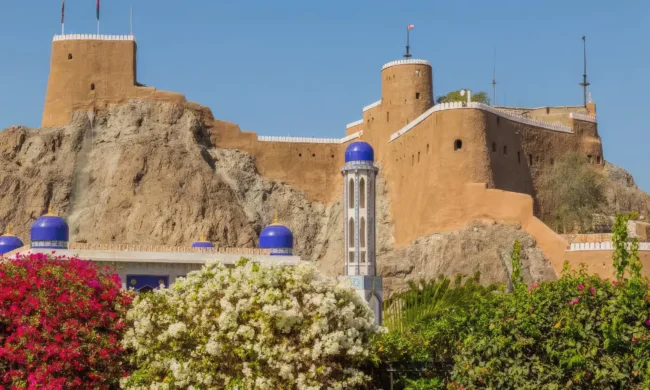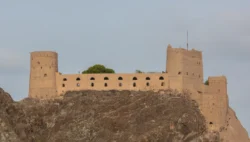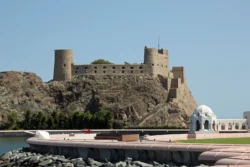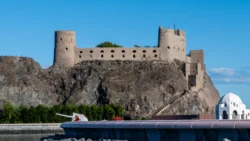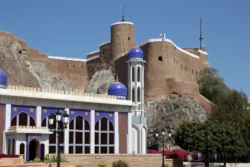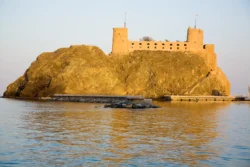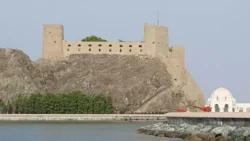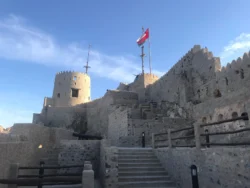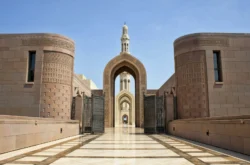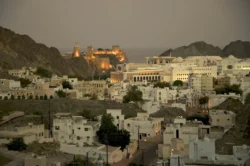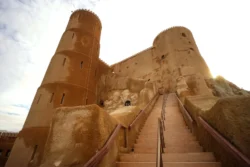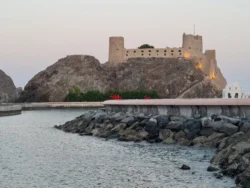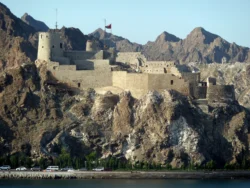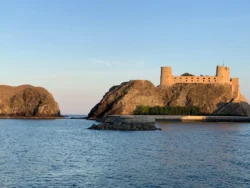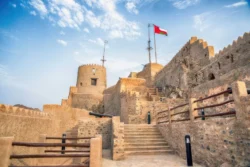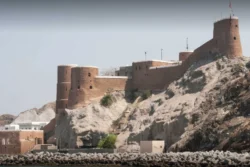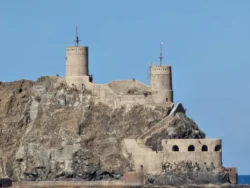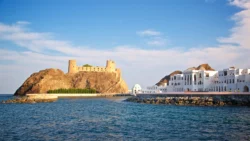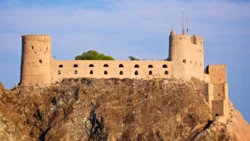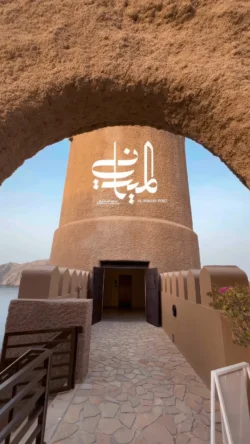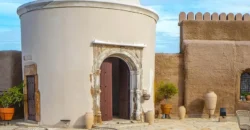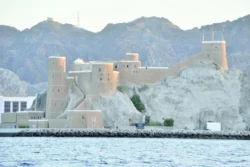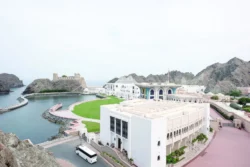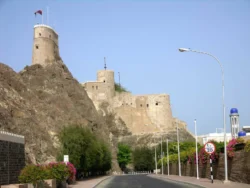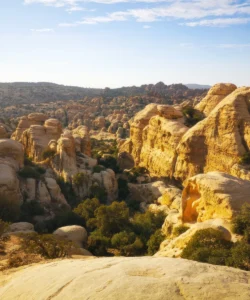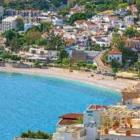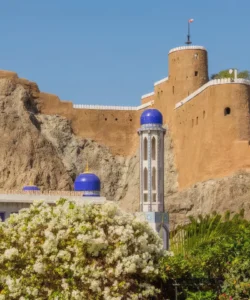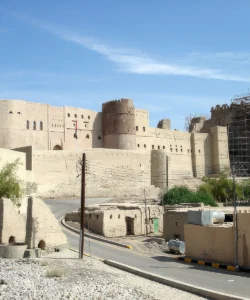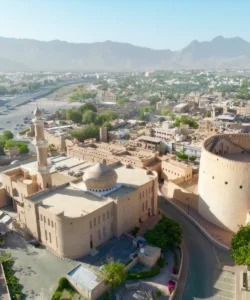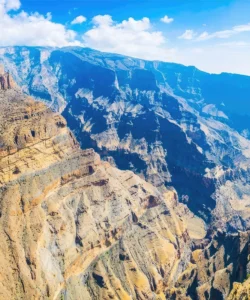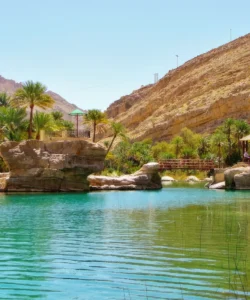Al Jalali Fort, an iconic historical landmark, is one of two formidable Portuguese-built forts guarding the entrance to Muscat Harbor in Oman. Standing majestically on a rocky outcrop, it has played a crucial role in defending the city for centuries.
Listen to an introduction about Al Jalali Fort
Name and Address
- Name: Al Jalali Fort (Arabic: قلعة الجلالي), also historically known as Ash Sharqiya Fort.
- Address: Located in Old Muscat, Sultanate of Oman, on the eastern side of the natural harbor. It faces its twin fort, Al Mirani, on the western side, with the Sultan’s Palace (Qasr Al Alam) nestled between them.
How to Get There
Access to Al Jalali Fort is restricted, as it is primarily used for official purposes. However, its imposing presence can be admired from several vantage points:
- By Car: You can drive to the Corniche in Old Muscat. There are public parking areas from which you can view the fort. It’s about a 20-30 minute drive from Ruwi or Muttrah, depending on traffic.
- By Foot: The best views are often obtained by walking along the Muscat Corniche or from outside the Sultan’s Palace.
- Boat Tours: Many local boat tours offer trips around Muscat Harbor, providing excellent panoramic views of Al Jalali and Al Mirani forts from the sea. This offers a unique perspective of their strategic positioning.
- Restricted Access: Please note that the fort is generally not open to the public for interior visits, unlike some other Omani forts. It serves as a historical and ceremonial landmark, sometimes hosting visiting dignitaries.
Landscape and Architecture
Al Jalali Fort’s architecture is a testament to its Portuguese origins, combined with Omani defensive adaptations, set against Muscat’s dramatic coastal landscape.
- Strategic Location: Perched on a steep, rugged rock face, the fort dramatically rises from the Gulf of Oman, making it naturally difficult to access and attack. Its position ensures complete command over the eastern approach to Muscat Harbor.
- Portuguese Design: Built by the Portuguese in the 16th century (around 1587-1588 AD), its design reflects European military architecture of the era, characterized by sturdy, thick walls and strategic gun emplacements.
- Robust Construction: The fort is primarily constructed from stone and mortar, forming massive walls that have withstood centuries of siege and the harsh coastal environment.
- Towers and Parapets: It features several rounded towers and battlements, designed to provide comprehensive defensive coverage. The fort’s internal structure includes courtyards, watchtowers, prisons, and ammunition stores.
- Restorations: Over the centuries, particularly in the 1980s under Sultan Qaboos bin Said Al Said, the fort underwent extensive restoration, meticulously preserving its historical integrity while ensuring its structural soundness.
- Coastal Integration: The fort seamlessly integrates with the natural rocky landscape, appearing as an extension of the cliff itself, further enhancing its impregnability.
What Makes It Famous
Al Jalali Fort’s fame is deeply rooted in its historical significance and unique role:
- Guardian of Muscat Harbor: Alongside Al Mirani Fort, it has historically served as one of the twin guardians of Muscat’s vital harbor, protecting the capital from maritime invasions for hundreds of years.
- Portuguese Legacy: It stands as a significant symbol of Oman’s colonial past, particularly the period of Portuguese occupation from 1507 to 1650 AD. The fort’s construction marked the peak of Portuguese military presence in the region.
- “Jalali” – A Name of Power: The name “Al Jalali” is believed to be derived from the Arabic word “Jalala,” meaning “great splendor” or “majesty,” reflecting its imposing nature and significance.
- Royal Prison: For a long period, especially until the mid-20th century, Al Jalali Fort was infamous as a high-security prison for political prisoners and criminals. This grim history adds another layer to its mystique.
- National Heritage Site: Today, it is a crucial part of Oman’s national heritage, symbolizing the nation’s resilience and historical continuity. It is used for special ceremonial events, including the firing of cannons for royal celebrations.
- Architectural Marvel: Its strategic location and formidable design make it a notable example of military architecture, showcasing the defensive ingenuity required for coastal fortifications.
Differences from Some Other Attractions
Al Jalali Fort offers a distinct experience compared to other Omani attractions, including its counterpart, Al Mirani, or more publicly accessible forts like Nizwa Fort.
- Restricted Access vs. Public Access: The most significant difference is its restricted access. Unlike Nizwa Fort, Jabrin Castle, or even some parts of Al Mirani Fort that are open to tourists, Al Jalali’s interior is generally closed to the public. This makes it more of an iconic exterior landmark than an interactive historical site.
- Primary Function: While many Omani forts served as administrative centers, residential palaces, or community hubs (like Bahla Fort’s integrated oasis), Al Jalali’s primary and continuous function has been purely military and defensive, particularly as a high-security prison for a considerable period.
- Portuguese Influence: While other forts like Nizwa and Bahla are quintessential examples of Omani or pre-Islamic mud-brick architecture, Al Jalali (along with Al Mirani) distinctly showcases Portuguese colonial military engineering. Its robust stone construction and European defensive layouts set it apart.
- Coastal Fortification: Unlike inland forts such as Nizwa or Bahla, which guarded trade routes and oases, Al Jalali’s existence is intrinsically tied to its role as a coastal defense against maritime threats, specifically guarding the entry to the capital’s harbor.
- Ceremonial Role: Its current use as a ceremonial venue for royal events, including the firing of historical cannons, gives it a unique status that differs from forts primarily preserved for tourism or museum purposes.
Al Jalali Fort Photos:
